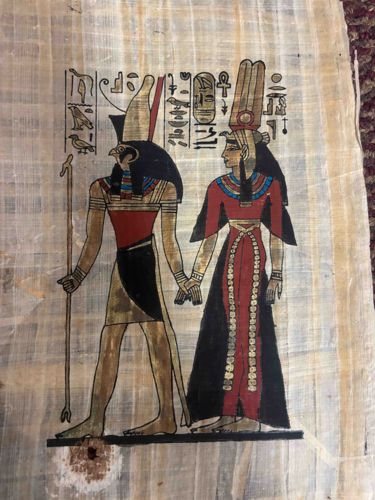
Egyptian Papyrus Painting depicting Horus and a Goddess
This item is an Egyptian papyrus painting featuring two primary figures: the god Horus, identifiable by his falcon head, and a goddess, possibly Hathor or Isis, given her distinctive headdress. The painting is executed on a sheet of traditional papyrus, showing the characteristic vertical and horizontal fibers inherent to the material, suggesting an authentic papyrus sheet rather than modern paper. The predominant colors used are red, black, gold/ochre, and blue, rendered in pigments that appear somewhat matte. Both figures are depicted in profile, a common artistic convention in ancient Egyptian art. Horus is shown holding a staff, adorned in a red skirt and a golden upper body, with a richly detailed necklace and armbands. The goddess wears a red tunic with black detailing, a long black skirt accented with metallic or golden elements, and an elaborate horned disk headdress. Both figures are stylized, with simplified anatomical features and bold outlines, typical of Egyptian artistic representations. Hieroglyphs are painted above and between the figures, likely representing their names, titles, or a relevant inscription. The papyrus itself exhibits signs of age and wear, including visible creasing, some discoloration, particularly along the edges, and minor textural inconsistencies. There are also notable brown stains, perhaps from water or other organic matter, present in the lower left portion of the image. The edges of the papyrus appear frayed and imperfectly cut, further suggesting a handcrafted material. While the painting style aims to emulate ancient Egyptian art, the precision of the lines and vibrancy of some colors might suggest a more modern creation, possibly a souvenir or reproduction rather than an antique artifact. The craftsmanship appears competent, with clear linework and consistent color application, though not necessarily indicative of ancient artisanry. The overall condition suggests careful handling despite the visible aging and staining, which appear consistent with the material's inherent fragility.
AI-Generated Appraisal Disclaimer
Estimated Value
$50 - $150
Basic Information
Category
Art / Decorative Object
Appraised On
December 23, 2025
Estimated Value
$50 - $150
Item Description
This item is an Egyptian papyrus painting featuring two primary figures: the god Horus, identifiable by his falcon head, and a goddess, possibly Hathor or Isis, given her distinctive headdress. The painting is executed on a sheet of traditional papyrus, showing the characteristic vertical and horizontal fibers inherent to the material, suggesting an authentic papyrus sheet rather than modern paper. The predominant colors used are red, black, gold/ochre, and blue, rendered in pigments that appear somewhat matte. Both figures are depicted in profile, a common artistic convention in ancient Egyptian art. Horus is shown holding a staff, adorned in a red skirt and a golden upper body, with a richly detailed necklace and armbands. The goddess wears a red tunic with black detailing, a long black skirt accented with metallic or golden elements, and an elaborate horned disk headdress. Both figures are stylized, with simplified anatomical features and bold outlines, typical of Egyptian artistic representations. Hieroglyphs are painted above and between the figures, likely representing their names, titles, or a relevant inscription. The papyrus itself exhibits signs of age and wear, including visible creasing, some discoloration, particularly along the edges, and minor textural inconsistencies. There are also notable brown stains, perhaps from water or other organic matter, present in the lower left portion of the image. The edges of the papyrus appear frayed and imperfectly cut, further suggesting a handcrafted material. While the painting style aims to emulate ancient Egyptian art, the precision of the lines and vibrancy of some colors might suggest a more modern creation, possibly a souvenir or reproduction rather than an antique artifact. The craftsmanship appears competent, with clear linework and consistent color application, though not necessarily indicative of ancient artisanry. The overall condition suggests careful handling despite the visible aging and staining, which appear consistent with the material's inherent fragility.
Get Your Items Appraised
Instant estimates of your treasures with AI-powered instant appraisals